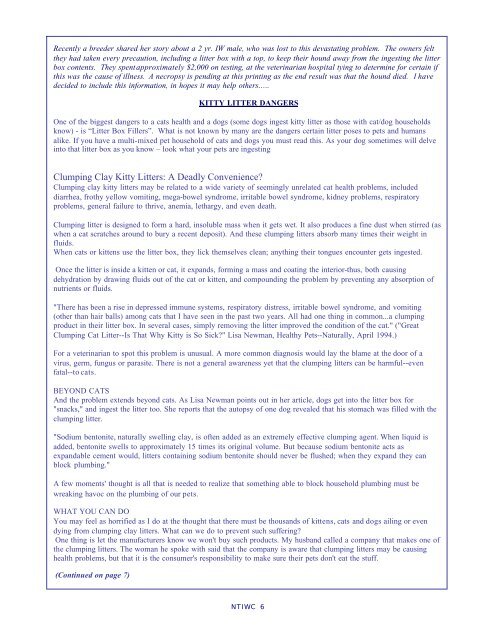NTIWC Newsletter - North Texas Irish Wolfhound Club
NTIWC Newsletter - North Texas Irish Wolfhound Club
NTIWC Newsletter - North Texas Irish Wolfhound Club
You also want an ePaper? Increase the reach of your titles
YUMPU automatically turns print PDFs into web optimized ePapers that Google loves.
Recently a breeder shared her story about a 2 yr. IW male, who was lost to this devastating problem. The owners felt<br />
they had taken every precaution, including a litter box with a top, to keep their hound away from the ingesting the litter<br />
box contents. They spent approximately $2,000 on testing, at the veterinarian hospital tying to determine for certain if<br />
this was the cause of illness. A necropsy is pending at this printing as the end result was that the hound died. I have<br />
decided to include this information, in hopes it may help others…..<br />
KITTY LITTER DANGERS<br />
One of the biggest dangers to a cats health and a dogs (some dogs ingest kitty litter as those with cat/dog households<br />
know) - is “Litter Box Fillers”. What is not known by many are the dangers certain litter poses to pets and humans<br />
alike. If you have a multi-mixed pet household of cats and dogs you must read this. As your dog sometimes will delve<br />
into that litter box as you know – look what your pets are ingesting<br />
Clumping Clay Kitty Litters: A Deadly Convenience?<br />
Clumping clay kitty litters may be related to a wide variety of seemingly unrelated cat health problems, included<br />
diarrhea, frothy yellow vomiting, mega-bowel syndrome, irritable bowel syndrome, kidney problems, respiratory<br />
problems, general failure to thrive, anemia, lethargy, and even death.<br />
Clumping litter is designed to form a hard, insoluble mass when it gets wet. It also produces a fine dust when stirred (as<br />
when a cat scratches around to bury a recent deposit). And these clumping litters absorb many times their weight in<br />
fluids.<br />
When cats or kittens use the litter box, they lick themselves clean; anything their tongues encounter gets ingested.<br />
Once the litter is inside a kitten or cat, it expands, forming a mass and coating the interior-thus, both causing<br />
dehydration by drawing fluids out of the cat or kitten, and compounding the problem by preventing any absorption of<br />
nutrients or fluids.<br />
"There has been a rise in depressed immune systems, respiratory distress, irritable bowel syndrome, and vomiting<br />
(other than hair balls) among cats that I have seen in the past two years. All had one thing in common...a clumping<br />
product in their litter box. In several cases, simply removing the litter improved the condition of the cat." ("Great<br />
Clumping Cat Litter--Is That Why Kitty is So Sick?" Lisa Newman, Healthy Pets--Naturally, April 1994.)<br />
For a veterinarian to spot this problem is unusual. A more common diagnosis would lay the blame at the door of a<br />
virus, germ, fungus or parasite. There is not a general awareness yet that the clumping litters can be harmful--even<br />
fatal--to cats.<br />
BEYOND CATS<br />
And the problem extends beyond cats. As Lisa Newman points out in her article, dogs get into the litter box for<br />
"snacks," and ingest the litter too. She reports that the autopsy of one dog revealed that his stomach was filled with the<br />
clumping litter.<br />
"Sodium bentonite, naturally swelling clay, is often added as an extremely effective clumping agent. When liquid is<br />
added, bentonite swells to approximately 15 times its original volume. But because sodium bentonite acts as<br />
expandable cement would, litters containing sodium bentonite should never be flushed; when they expand they can<br />
block plumbing."<br />
A few moments' thought is all that is needed to realize that something able to block household plumbing must be<br />
wreaking havoc on the plumbing of our pets.<br />
WHAT YOU CAN DO<br />
You may feel as horrified as I do at the thought that there must be thousands of kittens, cats and dogs ailing or even<br />
dying from clumping clay litters. What can we do to prevent such suffering?<br />
One thing is let the manufacturers know we won't buy such products. My husband called a company that makes one of<br />
the clumping litters. The woman he spoke with said that the company is aware that clumping litters may be causing<br />
health problems, but that it is the consumer's responsibility to make sure their pets don't eat the stuff.<br />
(Continued on page 7)<br />
<strong>NTIWC</strong> 6


